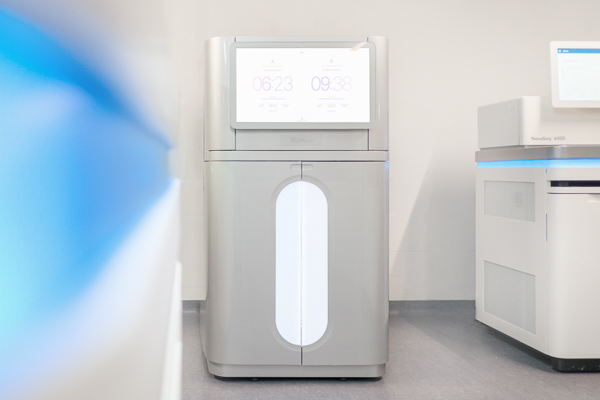DNA methylation is one of the most common epigenetic modifications that fundamentally influence gene expression, cellular differentiation, and genomic imprinting. Without any change in the DNA sequence itself, gene activity and function can be regulated by DNA methylation. DNA methyltransferases mediate the regulation of gene activity and function by transferring a methyl group to the fifth carbon of the cytosine ring. In mammals, the resulting 5-methylcytosines (5-mC) and 5-hydroxymethylcytosines (5-hmC) occur mainly in cytosine-phosphate-guanine (CpG) dinucleotides. However, methylation can also be found in non-CpG contexts in other organisms.
Changes in the epigenetic signature, especially in DNA methylation, have been reported to happen in normal cell development and aging. However, alterations in DNA methylation are also closely associated with diseases like cancer, metabolic disorders, and neurological diseases. Global hypomethylation and locus-specific hypermethylation of CpG islands have been shown to increase genomic instability and promote tumor progression.
High-quality methylation data analysis can be used for:
- biomarker discovery
- clinical studies with methylation-associated treatments or other clinical and scientific applications
- exploration of cell differentiation mechanisms, characteristic methylation profiles, and specific tissue development
We offer different Whole Genome Methylation Sequencing (WGM) products to realize your research project.
CeGaT Is the Best Partner for Sequencing Your Project
Our Commitment to You
Fast Processing
Turnaround time
≤ 15 business days
High Quality
Highest accuracy for all processes
Secure Delivery
Secure provision of sequenced data via in-house servers
Safe Storage
Safe storage of samples and data after project completion
Our Service
We provide a comprehensive and first-class project support – from selecting the appropriate product to evaluating the data. Each project is supervised by a committed scientist. You will have a contact person throughout the whole project.
Our service includes:
- detailed project consulting
- product selection tailored to your project
- detailed bioinformatic evaluation of your data
- detailed project report with information about sample quality, sequencing parameters, bioinformatic analysis, and results
Benefit from our dedicated support and accredited workflows.
Explore Our Product Portfolio for Methylation Sequencing
We offer different Whole Genome Methylation Sequencing (WGM) products to address a variety of research questions. Would you like to have bioinformatic analyses performed on your data in addition to the included deliverables? Each of our products can be supplemented with further services. We are happy to advise you.
WGM Classic | WGM Flex | HiFi WGM |
Species | Species | Species |
DNA quality | DNA quality | DNA quality |
Detection method | Detection method | Detection method |
Sequencing platform | Sequencing platform | Sequencing platform |
Output | Output | Output |
Included deliverables | Included deliverables | Included deliverables |
Bioinformatics
For WGM Classic and WGM Flex, the raw sequencing data are automatically processed. We offer different levels of bioinformatic analysis for those two products. The default level is Level 1. With increasing bioinformatic level, more data are delivered. All higher levels include the data from the lower levels. In addition to the data, and independent of the analysis level, a project report is generated
For our HiFi WGM product, we offer one level of bioinformatic analysis, which includes:
Level 1:
- demultiplexing and adapter trimming of the sequencing data (FASTQ format)
Level 2:
- mapping of the sequencing data (BAM format)
- conversion rate (analysis of positive (pUC19) and negative control (lambda phage) for each sample (TSV format)
- methylation calling, including:
- M-bias report (TXT format)
- cytosine report (TXT format)
- methylation metrics (TSV and PDF format)
- coverage metrics (TSV and PDF format)
Level 1:
- demultiplexing and clipping of the sequencing data (clipped BAM format)
- clipped sequencing data in FASTQ format
- mapping of the sequencing data (BAM and PBI format)
- methylation calling (BED and BIGWIG format)
Technical Information
CeGaT’s WGM Classic and WGM Flex products offer the genome-wide detection of methylation patterns, including regions with low cytosine-phosphate-guanine (CpG) density. During library generation, unmethylated cytosines are converted to uracils, and can therefore be distinguished from methylated and hydroxymethylated cytosines. For the conversion, we use the enzyme-based method (enzymatic Methyl-Seq, EM-seq™). Compared to conventional bisulfite conversion, which is traditionally applied for whole genome bisulfite sequencing (WGBS), the gentler enzymatic conversion causes significantly less DNA damage, leading to highly accurate methylation determination. For more details, please have a look at our Tech Note. For WGM Classic and WGM Flex, paired-end sequencing (2 x 150 bp) is performed using the Illumina sequencing platforms.
Our HiFi WGM product uses PacBio’s long-read sequencing technology to detect epigenetic changes without changing or converting the DNA bases. Thus, no library preparation or sequencing workflow modifications are required. During the sequencing process, methylated cytosines in the context of CpG sites are detected based on the impact of the base incorporation’s kinetics. Our PacBio platform enables us to sequence DNA fragments of up to 18 kb.
If you require other sequencing parameters for one of our Methylation sequencing products, please let us know! We can provide further solutions.
Further Information about Methylation Sequencing
The genetic code is comprised of the four bases adenine (A), guanine (G), thymine (T), and cytosine (C). Determining their sequence is done using whole genome sequencing. Whole genome sequencing can give insight into variations in the genetic code, including single nucleotide variants (SNVs), small insertions and deletions (indels), copy number variants (CNVs), and structural variants. These variations can play a pivotal role in diseases. Thus, whole genome sequencing can contribute, amongst others, to disease research, cancer studies, personalized medicine approaches, and translational medicine.
In Epigenomics, the changes in gene function are studied that are not due to changes in the genome sequence, e.g., due to mutations or recombination. These epigenetic changes in gene function are passed on to daughter cells. This is done, for example, by methylation of cytosines. Especially cytosines that are followed by guanines, so-called CpG regions, are modified. If the fifth carbon position is modified with a methyl group, a 5-methylcytosine (5mC) is generated. The oxidation of this 5mC results in the formation of 5-hydroxymethylcytosine (5hmC). This DNA methylation can be associated with altered gene expression. Methylated cytosines are, for example, present at transcription start sites of repressed genes. However, methylation can also be associated with gene activation, e.g., during development. Thus, revealing the methylation pattern of a cell can have pivotal implications for the understanding of biological processes, such as aging, but also for diagnosing diseases, such as cancer, atherosclerosis, cardiovascular diseases, or nervous disorders.
For this reason, the enzymatic methyl-sequencing (EM-Seq) was developed as one method to determine the methylation of the genome. In two enzymatic reactions, 5mC and 5hmC are detected. First, the two enzymes tet methylcytosine dioxygenase 2 (TET2) and T4 phage β-glucosyltransferase (T4-BGT) convert the methylated cytosines into products that cannot be deaminated. Next, apolipoprotein B mRNA editing enzyme catalytic subunit 3A (APOBEC3A) deaminates all cytosines that are not modified. With these three enzymes, methylated cytosines can be identified.
The enzymatic methyl-sequencing has several advantages compared to bisulfite sequencing:
-
As the enzyme conversion is gentler than the bisulfite conversion, less DNA damage is observed in the enzyme methyl-seq. Lesser DNA damage results in libraries with longer inserts, facilitating the mapping of the reads.
-
In addition to longer inserts, the gentler enzyme methyl-seq also enables higher quality of the libraries, which can be amplified more efficiently. The result of this efficient amplification is a higher yield with less PCR cycles. Additionally, enzyme methyl-seq shows constantly low duplicate values, independent of the amount of input material.
-
In bisulfite sequencing, especially CpG regions suffer from the harsh conversion. In these CpG regions, more damage, breaks, and losses occur, leading to an underrepresentation of these regions in the bisulfite sequencing. This bias is not observable in the enzyme methyl-seq: EM-seq libraries show a consistent GC coverage.
Enzyme methyl-sequencing is a gentle and straight-forward way to analyze the methylation patterns of a genome. EM-seq opens new possibilities for research and clinical applications, increasing the understanding of epigenetics in the context of health and disease.
With PacBio’s long-read HiFi sequencing, CeGaT offers a second option to determine your sample’s methylation status. In contrast to whole genome bisulfite sequencing or enzymatic methyl-sequencing, no DNA modifications or conversion are required in this approach to detect methylation of 5-methylcytosines (5mC) in the context of CpG-regions. The fluorescence signal is detected during the sequencing process to determine the incorporated nucleotide accurately. In addition, the kinetics of the polymerase are measured. The base context and the epigenetic changes impact the nucleotide incorporation kinetics. Thus, additionally, detecting the kinetics gives valuable information about the methylation status without converting the bases before the sequencing. A convolutional neural network processes the measured kinetics to determine the methylation status of each CpG site. With this neural network, the probability of methylation for each CpG site is reported.
Downloads
Contact Us
Do you have a question or are you interested in our service? Feel free to contact us. We will take care of your request as soon as possible.
Start Your Project with Us
We are happy to discuss sequencing options and to find a solution specifically tailored to your clinical study or research project.
When getting in contact, please specify sample information including starting material, number of samples, preferred library preparation option, preferred sequencing depth and required bioinformatic analysis level, if possible.






